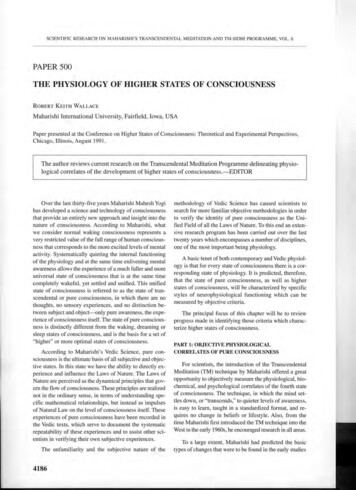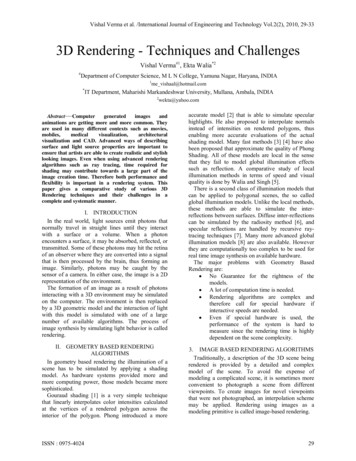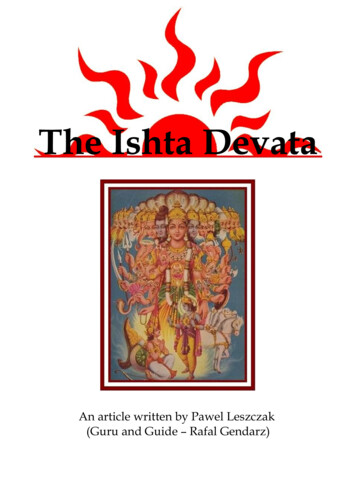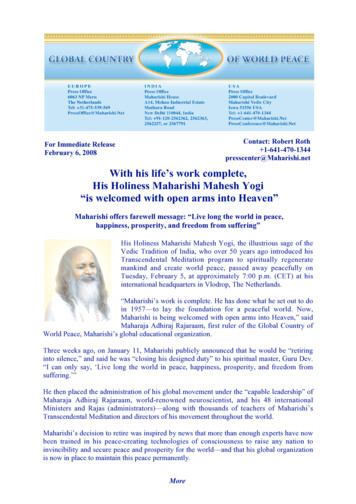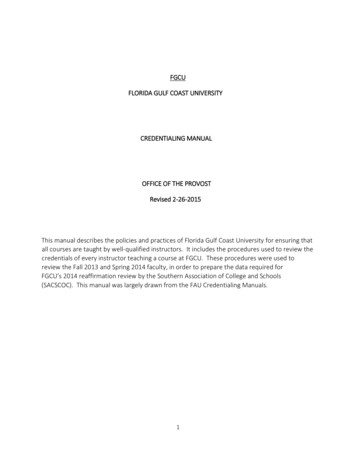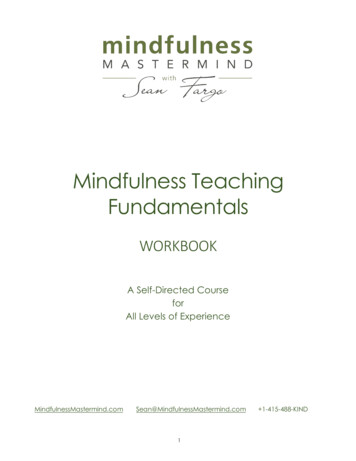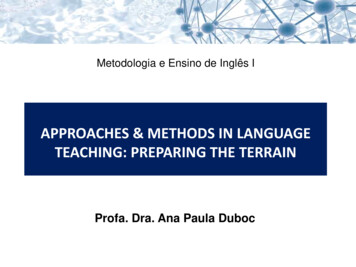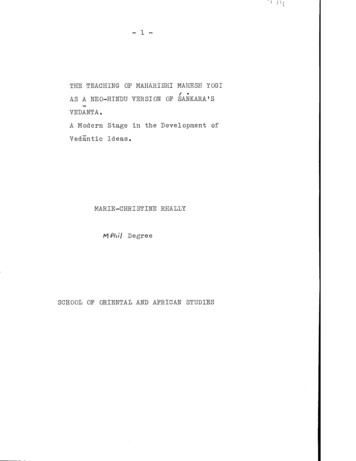
Transcription
1THE TEACHING OP MAHARISHI MAHESH YOGIAS A NEO-HINDU VERSION OP SANKARA'SVEDANTA*A Modern Stage in the Development ofVedantic Ideas.MARIE-CHRISTINE RHALLYM PhiI DegreeSCHOOL OP ORIENTAL AND APRICAN STUDIES
ProQuest Number: 10672887All rights reservedINFORMATION TO ALL USERSThe quality of this reproduction is d e p e n d e n t upon the quality of the copy subm itted.In the unlikely e v e n t that the a u thor did not send a c o m p le te m anuscriptand there are missing pages, these will be noted. Also, if m aterial had to be rem oved,a n o te will ind ica te the deletion.uestProQuest 10672887Published by ProQuest LLC(2017). C opyright of the Dissertation is held by the Author.All rights reserved.This work is protected against unauthorized copying under Title 17, United States C o d eM icroform Edition ProQuest LLC.ProQuest LLC.789 East Eisenhower ParkwayP.O. Box 1346Ann Arbor, Ml 4 8 1 0 6 - 1346
2 -ABSTRACTMaharishi Mahesh Yogi is an Indian spiritual teacherwho has had a considerable influence in the Westover the past twenty years.His teaching has twoaspects, practical (the practice of TranscendentalMeditation) and theoretical As a philosopher,Maharishi claims to be an exponent of the Advaita/Vedanta according to Saftkara, yet his presentationis modern and practical,This thesis examines the question how far Maharishi’sclaim to be an authentic exponent of aftkara’sVedanta can be sustained, and concludes that althoughhis teaching does essentially agree with that of/Saftkara, it differs from this in emphasis;inaddition Maharishi has introduced a number of apparentinnovations, probably owing to modern Western influences.In this respect Maharishi’s theoretical approach alsodiffers from that of other neo-hindu movements in theWest, most of which are either very traditional, ormore overtly devotional and religious.
-3-TABLE OF CONTENTSCHAPTER I : INTRODUCTION .81. Preface.82. Maharishi Mahesh Yogi - A Biographical Sketch.113. Sankara - A Biographical Sketch. 164. Maharishi's Movement.23a) A Short Introduction. .23b) Organizations .33c) Terminology . 35CHAPTER II; THE VEDANTA IN RELATION TO ALTEREDSTATES OP CONSCIOUSNESS. 41CHAPTER III; TRANSCENDENTAL CONSCIOUSNESS. 611. Maharishi’s Psychological Description ofTranscendental Consciousness.2. Maharishi's Philosophical Position. a) Saccidananda.616768b) The Nature of the Fourth State. 69c) Jlva and Jtman. .71d) Metaphysical and PsychologicalSubject. 72e) The Immortality of Jiva. 73f) The Self Unfolds Itself by Itself to Itself.743. Historical Parallels in the Advaita Vedantawith Special Reference to ISaftkara. 77
„4-a) The Nature of the Fourth State. 77b) Saccidananda*79c) Jiva and Jtman. 80d) The Immortality of Jiva. 86e) The Self Reveals Itself by Itself to Itself.874. C oncluding Remarks. 89CHAPTER IV: COSMIC CONSCIOUSNESS. 911. Maharishi*s Psychological Description ofCosmic Consciousness.91. a) The Nature of Cosmic Consciousness. 92b) Maharishi* s Theory of Stress. 942. Maharishi *s Philosophical Position.993. Historical Parallels in the Advaita Vedantawith Special Reference to Saftkara.1074. Concluding Remarks. 117CHAPTER V ; LIBERATION IN COSMIC CONSCIOUSNESS. 1191. Ethical Implications of Cosmic Consciousness.1192. Historical Parallels in the Vedanta.1333. Concluding Remarks.144CHAPTER V I ; GOD CONSCIOUSNESS. 1491. Maharishi 's Psychological Description. 1512. Maharishi 's Philosophical Position. 1613. Historical Parallels in the Advaita Vedanta/ ,with Special Reference to Sankara. 1674. Concluding Remarks.182
-5-CHAPTER VIIi BRAHMAN CONSCIOUSNESS.1851 o Mahar ishi ’s Theory of Unity* o «* « «i»o «t»oi«*1852. Historical Parallels in the Advaita Vedanta/.with Special Reference to Sankara.,,.*„ 1993 o C oneluding Remarks.*.* .***s***«******«209CHAPTER VIII: CONCLUSION. . ./213.1. Points of Agreement with Sankara’s Vedanta * 213a ) The Pourth Stateaeooo ooo. ooo.e s.oBo*o.o oo213b) The Witnessing Self. . *. . .*.* 214c) The PerS onalGrOd ae.Qas.oo.o.*«ae oa.«o.ea ».215d) The Unity of Cause and Effect. 2162 Points of Difference from Sankara’s Theory. .217a) An”Applied" Vedanta. . *. .217b) The Systematization into Seven States. 219c) Maharishi’s Emphasis on Cosmic Consciousness 222d) The Theory of Stress. , . . . 225e) Maharishi’s Attitude to the Other Systems .of Indian Philosophy.« *.» *«.o . *. .* . 228f) Maharishi as a Practical Teacher.**.230CHAPTER IX; MAHARISHI!S MOVEMENT COMPARED WITHSOME OTHER NEO-HINDU MOVEMENTS INTHE WE ST2351. The Vedanta Society and the Teaching ofRaman a M aharshi «o . «.o.eoooe « a.*.*o .e.*.235
- 6 -2. The Movements of Krishna Consciousness, ofBhagavan Shree Rajneesh, the Divine LightMission of Guru Maharaj and Ananda Marga. .240a) The Radha Krishna Temple and KrishnaConsclousness Society.**.240b) Kalptaru or the Dynamic Meditation of.Bhagavan Shree Rajneesh.242c)The Divine Light Mission of Guru Maharaj. 245d)The Ananda Marga Yoga Society. 247NOTES AND REFERENCES. .249BIBLIOGRAPHY ON THE TEACHING OF MAHARISHIMAHE SH Y OGI.a*.260UNPUBLISHED MATERIAL ON THE TEACHING OFMAHARISHI MAHESH YOGI.263GENERAL BIBLIOGRAPHY265.
-7-NOTE ON TRANSLITERATIONQuotations from Sanskrit sources, also my own useof Sanskrit terms, will be transliterated in theconventional way.Proper names will be given in their prevalent form,Ex. Maharishi, Maharshi, Ramakrishna, Rishikesh,
CHAPTER IINTRODUCTION1.PrefaceMaharishi Mahesh Yogi describes himself to theWest as an Indian "monk".He is the founder of theSpiritual Regeneration Movement and other alliedorganizations for the propagation of his meditationtechnique called transcendental meditation. Sincethe late 1970s he has become a leading "guru" inIndia and also particularly in the Western world.Historically, his teaching is of interest fortwo reasons :1) His approach to Western Society and histeaching methods are uniquely practical and "modern"and this lends his teaching a quality that is verydifferent from that of other Indian teachers whetherof the past or indeed the present time.2) He claims to be an exponent of Advaita—/Vedanta philosophy in the tradition of Sankara andin that respect his modern style is coupled with acharacteristically Indian ideological conservatism.These two elements seem to coexist in Maharishiattitudes in an exceptional way, and in that sense hiteaching is a landmark in the exposition of Sankara1s
gVedanta philosophy in the West.Maharishi1s teaching is twofold : Practical andtheoretical.The practical aspect is the techniqueof transcendental meditation and the theoretical aspectis the philosophy behind it.In this thesis I willdiscuss the theoretical aspect of this teaching inconnection with Sankara's Advaita from which he claimsit to stem.First, however,I will give an outline ofMaharishi1s movement and of his approach to teachingand to Western values that has given it its strongatmosphere of modern practicality.Following that, I will discuss Maharishi1sphilosophy in relation to Sankara's Vedanta,in orderto establish how far he is a strict exponent ofSankara's theory and how far he is original.This will lead to a conclusion on the effect,if any, that modern attitudes may have had on hispresentation of the Advaita Vedanta.Maharishi is the author of two books :1. "The Science of Being and Art of Living" in whichhe explains what transcendental meditation is andgives a popularized version of the philosophy behindit.2. "Bhagavad-Glta, a New Translation and Commentary
- 10 -Chapters 1-6" which is his interpretation of thefirst six chapters of the Bhagavad-Gita.He has also written an unpublished commentaryon the Brahma Sutra.
- 11 -2. Maharishi Mahesh Yogi - A Biographical SketchVery little is known about Maharishi1s earlylife and this is from his own accounts.disciple of Svami Brahmananda SarasvatiHe was a(1869-1953)Sankaracarya of Jyotir Math, himself a follower ofSvami Krsnananda Sarasvati of Uttar Kashi. For mostof his life Svami Brahmananda was a strict recluse,first in the Himalaya and later in the Amarkantakaand Vindhyagiri mountains.For the last thirteenyears of his life, however, hebecametheSankaracarya of Jyotir Math, a position to whichhe came in 1941 at the age of seventy-two. He wasconsidered to be a man of great authority and anexponent of Vedanta philosophy with a wide following,and was recognized as such by Radhakrishnan amongothers. According to his own account, Maharishi studiedphysics and chemistry at the University of Allahabadbefore joining the Sankaracarya as a brahmacarin.He stayed with him for twelve years until the deathof the Sankaracarya in 1953, at which time he retiredto a cave where he lived in silence and meditationfor the next three years.When Maharishi emerged from his cave, he wentto Kerala where he lectured on his new meditationtechnique, the transcendental deep meditation as itwas then called.It seems very likely that he evolved
- 12 -this technique during his three years of silence.However, he claimed, this was not really a newtechnique at all but a very ancient one, which hehad once more brought to light.This reflects acommon Indian attitude according to which anytheory with a claim to respectability ought tostem from the authority of ancient wisdom.After leaving Kerala, Maharishi spent twoyears travelling and teaching throughout Indiaand in 1958 he founded the Spiritual RegenerationMovement in Madras.Then, travelling east, hetaught in Singapore and in Hawaii whence he cameto California in 1959.California was then, as itis now, a place where spiritual movements flourished;Yogananda had taught Kriya Yoga there.Maharishistayed for some time and established an Americancentre for his movement.A first-hand account ofhis presence there, though personal and not veryinformed, is given by Helena Olson in her book3,lA Hermit in the House”. From Calif ornia,Maharishi4moved on to New York and eventually to Europe.California remains the headquarters of the Americanchapter of his movement to this day.Until this time, Maharishi both lectured andtaught meditation himself.In order to propagatehis teaching more widely, he eventually decided totrain teachers of transcendental meditation, whom
- 13 -at first he called "meditation guides".During the next ten years he taught twothree-monthly teacher training courses a yearfrom September to March, and used the rest ofthe year for lecturing and teaching meditationin India and in the West.Teacher trainingcourses were then held at his asrama in thefoothills of the Himalaya overlooking the smalltown of Rishikesh in Uttar Pradesh, on the bankof the Ganges.Rishikesh,situated as it is justupstream from the sacred town of Hardwar, nearthe source of the Ganges is an ideal spot for sucha purpose and quite a few similar movements haveasramas there."monkey-leaped"Maharishi 1s alsrama, in the5jungle of the hills,offeredrudimentary accommodation for courses, constructedon land especially donated for the purpose by theIndian government.Thirty people took part in the first suchcourse for Westerners, apparently a considerablefeat on their part, as living conditions seem tohave been quite uncomfortable at that time.Numberssteadily increased, however, and conditions graduallyimproved,until, by 1970, two hundred people percourse enjoyed a pleasant, if simple stay, whilelearning to impart the technique of transcendentalmeditation.
- 14 -As applicants for his courses continued toincrease and Maharishi decided to throw open thedoors so that more people would be able to trainas teachers, the small asrama near Rishikesh wasno longer adequate.From 1970 onwards, he haspreferred to hold such courses in Europe wherefacilities for greater numbers of participantsare more easily available. By 1975 approximatelyten thousand people had been trained to teach thetechnique, now widely known as transcendentalmeditation.Gradually the original Spiritual RegenerationMovement branched out into a variety of sisterorganizations such as the Students InternationalMeditation Society, the International MeditationSociety, and others which will be discussed atgreater length in the next section. As numbersgrew, Maharishi relegated the teaching of themeditation to the teachers he had trained, while,since 1976, he has concentrated his own effortsto the advanced training of existing teachers,sothat they would be capable of undertaking to teachteacher training courses themselves.Thus hisactivity is now almost exclusively restricted toconducting such "post-graduate type" courses.Consequently he leads a very secluded life farfrom the public eye and has become increasingly
- 15 -inaccessible even to his own followers.He stilltravels, though he also spends long periods eitherat his Indian asrama, or at the headquarters ofhis movement in Europe.
- 16 -3. Sankara - A Biographical SketchSankara is the main exponent of the Indiantheory of non-duality or strict monism (Advaita)on which Maharishi bases the theoretical aspectof his teaching.Maharishi claims to belong tothe Vedantic tradition as expounded by Sankaraby virtue of his apprenticeship with the previousSankaracaryaof Jyotir Math; he also claims,byvirtue of the insight he has gained, to shed newlight on Sankara's pronouncements. My purpose isto examine the theoretical aspect of Maharishi'swork to establish whether or not it agrees withSankara 1s teaching.Very little is actually known concerningSankara's life.He is generally thought to havelived in the 8th century A.D. The Aryavidhyasudhakaragives the following account of his birth ;"sahkaracaryapradhurbhavas tu vikramarkasamayadatlte pancacatvarimsadadhika astasatlmitesamvatsare keraladesekalapigramesivagurusarmano bharyayamsamabhavat.""The birth of Sankara from the wife ofSivagurusarman occured in the territory of
- 17 -Kerala in the village of Kalapi after the845th year of the Vikramarka(Vikramaditya)era had passed. 116The 845th year of the Vikramaditya era whichis referred to here corresponds, according to thesame text,with the year 3889 of the Kaliyuga whichis traditionally said to have begun on 8th February3102 B.C. thus giving 787 - 789 A.D. as the year ofhis birth.The text quotes a tradition accordingto which year 3889 of the Kaliyuga was called theyear sea-elephant-mountain-beast-fire, in whichSankara was born in the month of Madhava, on thetenth day of the bright fortnight.Western scholars such as Max Muller,A.Macdonnelland A.B.Keith follow this source.7They hold thatSankara was probably born in 788 A.D. and died in820 A.D.Others have offered earlier dates but havenot received much support.The little that is knownabout Sankara's life is mostly from traditionalmaterial and not from reliable historical sources.A.B.Keith sums it up like this :"The biographies alleged, absurdly, to be byAnandagiri,his pupil, the Sahkaravijaya, andMadhava1s Sankaradigvijaya are worthless,and
- 18 -many works attributed to him are probablynot hi s ." According to tradition, Sankara was probably/a Saiva and a student of Govinda, himself a followerof Gaudapada, from whom he must have learnt themain tenets of Advaita philosophy. He becameaprominent spiritual teacher, wandering as far asKas'mir in order to teach his version of Vedanta, anda sannyasin.At the time when Sankara is thought to havelived the Pallava dynasty was in power in SouthIndia.A Brahmanical influence from the north hadbecome strong, but was challenged by the idealisticattitudes of Buddhism and by the devotional popularcults.Theological debates abounded owing to thecontroversy between Buddhist and Hindu ideas.Hindu colleges or ghatikas were attached totemples and in the eighth century there developeda new institution called a matha.The matha wasa rest, food and education centre which upheld thetheological views of the particular sect with whichit was associated.Such centres soon existed allover the subcontinent, especially at places of
- 19 -pilgrimage, where they could be more influential.Thus Sankara must have lived at a time ofinteresting theological developments. In orderto further the cause of Brahmanism he strove tomake it more understandable and more acceptableto the people at large.To him the Vedic traditionwas sacred and not open to question but he opposedthe obscurantism with which it had been enveloped.He also opposed the sometimes severe excesses thatwere indulged in by the popular devotional cults.To establish what he considered to be a clear andlogical understanding of Hinduism, he set up hisown mathas and founded an order of Hindu asceticswho travelled throughout India in order to propagatehis teaching.The four main mathas were at Badrinath,Puri, Dvaraka and Sringagiri, but there were soonbranches elsewhere and his movement rapidly grew.The rapid spreading of Sahkara1s teaching is takenas an indication of the increasing contact thatexisted among various Indian regions at this time.9Sankara is traditionally thought to have showngreat enthusiasm and dialectic ability in discussionand theological debate and is considered to be oneof India1s most prominent spiritual teachers bothon account of his teaching ability and the contentof his philosophical system.His personal teaching
- 20 -was of short duration, however; he is supposed tohave died either at Kanci or at Kedarnath at theage of thirty-two.Many works have been ascribed to Sankara,though it is doubtful whether they are all his.To quote Keith again :"Many commentaries on the Upanisads, one onthe Bhagavad-Gita, and the Bhasya on theBrahma Sutra are genuine, nor need we doubtthe ascription to the Upadesasahasri,threechapters in prose and. nineteen in verse,orvarious other works including lyrics ofconsiderable power and the Atmabodha insixty-seven stanzas with commentary."/Sankara's theory is an elaboration of the systemof the Vedanta. The Vedanta attempts a synthesis ofthe teaching of Vedic writings on the supreme knowledgeof Brahman. It is first expressed in the Vedanta orBrahma Sutras traditionally attributed to Badarayanawho is occasionally identified with the legendary Vyasa.The dates offered for this work vary, as Indian textsin general are notoriously difficult to date, but itis probably fair to say that it was composed around200 A.D.
- 21 -The earliest extant work derived from this isthe GaudapadiyaKarika, 215 verses attributed*Gaudapada.toAccording to tradition, Gaudapada wasthe teacher of Govinda, the teacher of Sankara,and this would date him near the end of the 7thcentury and the beginning of the 8th century.Gaudapada introduces the idea of the illusorycharacter of empirical existence which was laterto be more elaborated by Sankara.Sankara's main contribution to the Vedantawas his insistence on the ultimate absence ofduality, the theory of non-duality(Advaita) onwhich he based his philosophical outlook and whichhe expounds in great detail.This is the subjectmatter of most of his work, particularly theBrahma Sutra commentary.In this commentary Sankara upholds the Vedictradition and orthodox Brahmanical theology andconsiders Brahman as the supreme and ultimatereality superior to both the Vedic sacrifice andthe objects of popular devotion such as Visnu andSiva.Though empirical existence is commonlyperceived as being separate from Brahman, Brahmanis in fact all-inclusive containing all existenceand can ultimately be known as such.
— 22 —Though this theory of Sankara's has beenchallenged both by heterodox sects and by Vedantistswith less absolute views,it is still consideredone of the most influential philosophical theoriesin India.George Thibaut in his Vedanta SutrasofBadarayana, expresses the view that no Indian system"can be compared with the so-called orthodoxVedanta in boldness, depth, and subtletyofspeculation" and he continues to say that :"The Sankara-bhasya further is the authoritymost generally deferred to in India as to theright understanding of the Vedanta Sutras,andever since Sankara's time the majority of thebest thinkers of India have been men belongingto his school."12
- 23 -4. Maharishi1s Movementa) A Short IntroductionBefore I discuss the theoretical aspect ofMaharishi's teaching in relation to the AdvaitaVedanta,I will give a brief introductory outlineof his movement with special reference to otherIndian movements in the West, contemporary Westernculture and modern religious thought.A large number of Indian teachers and movementshave come to the West since the Ramakrishna movementwas introduced by Svami Vivekananda at the end of thenineteenth century, and Vedanta-orientated movementshave played a leading part in introducing Indianphilosophy to the West.More recently, many groupsclaiming to teach yoga have sprung up demonstratinghatha yoga and breathing excercises, and many of thesehave included mental concentration and contemplationor various forms of psychotherapyamongtheirpractices.Some of these philosophical systems or movementsare not religions nor do they claim to be. However,inmany cases they become a way of life to the peoplewho follow them and provide some spiritual answerswhich, though not necessarily overtly religious,oftenseem to satisfy the intellectual and spiritual needsof their followers.Those groups which include forms
- 24 -of meditation or contemplation in their teachingoffer a potential spiritual or "mystical" experiencewhich, in itself, holds a great fascinationformodern Westerners.It is unfortunately very difficult to find aneutral term to refer to this kind of experience."Mysticism" is a notoriously vague term. In hisVocabulaire de la Philosophie, Lalande definesmysticism as a"belief in the possibility of an intimateand direct union of the human spirit withthe fundamental principle of being, a unionwhich constitutes at once a mode of existenceand a mode of knowledge different fromandsuperior to normal existence and knowledge." 13However the term "mystical" is frequentlypejorative outside religious circles and indeedwithin some of them, carrying overtones of mystification,mumbo-jumbo and obscurantism.avoided.It is therefore betterModern secular psychologists such as Tart,who have studied this realm of experience scientifically,have coined the term: altered states of consciousness.This has the advantage of being neutral as regards theorigin and significance of experiences of this type.
- 25 -There have been considerable differences inemphasis among Indian movements in the West; somehave been primarily intellectual such as that ofAurobindo, others ecstatic and emotional such asthe Divine Light Mission started by a 17 year oldboy called Guru Maharaj, or the Radha KrishnaTemple and Krishna Consciousness Society (HareKrishna movement), while others have been primarilyphysical and mainly concerned with Hatha Yoga.Nearly all, however, have emphasized their Indiancharacter though they have often adopted Westernideas of science and evolution.The practical aspect of Maharishi‘s teachingis based on the application of a meditation techniqueand in this respect it does not at first glance differfrom the majority of Indian movements in the Westtoday, which make use of a variety of meditationalpractices.In fact, however, there are a number ofimportant differences.Although Maharishi has never minimized hisIndian origins, his initial presentationoftranscendental meditation to the West was as apractical technique free from religious overtones primarily a method for alleviating the effects ofstress.14This technique is also claimed to becompletely effortless and suitable for every man
- 26 -and women from all walks of life and children overfour years of age. This comes as a surprisetomany people who expect meditation to be a difficultand demanding mental excercise accompanied by strictregulations of behaviour in everyday life. Someother groups - though not all - suggest changes inbehaviour and lifestyle and most base their meditationson contemplation or concentration techniques in whicha degree of effort, in many cases a considerable one,is involved.Maharishi claims that transcendental meditationis effortless because it is based on the principleof the attracted rather than the directed mind. Heconsiders concentration to be a strenuousandunnecessary excercise because he believes that ratherthan directing the mind to the experience of certainstates of awareness,it is more effective to allowit to be attracted by those states.He holds thatthrough the process of transcendental meditation,".the mind finds the way increasingly attractiveas it advances in the direction of bliss. A lightbecomes faint and dim as we move away from itssource, and its intensity increases as we proceedtowards its source.Similarly, when the mindgoes in the direction of the absolute bliss of
- 27 -transcendental Being, it finds increasing charmat every step of its march. The mind is charmedand so is led to experience transcendental Being.This practice is pleasant for every mind.Whatever the state of evolution of the aspirant,whether he is emotionally developedorintellectually advanced, his mind, by its verytendency to go to a field of greater happiness,finds a way to transcend the subtlest state ofthinking and arrive at the bliss of absoluteBeing.This practice is, therefore, not onlysimple but also automatic." 15It is not possible to either prove or disprovethis statement, which is merely included hereforthe purpose of illustrating what is meant by theprinciple of the attracted mind.From the practicalpoint of view, however, meditators practisingthetechnique unequivocally confirm that it is effortlessand pleasant and a vast majority report that theyfind it beneficial.16It does not require orpresuppose any change in lifestyle or the adoptionof any particular belief on the part of beginners,who simply add the technique to their existing dailyactivities for one twenty minute period inmorning and one in the evening.Intheaddition
- 28 -Maharishi claims that the technique produces quickresults and is completely safe, unlike certainsystems of inner development - KundalinI Yoga isan example - which have been criticised as beingphysically or mentally dangerous unless they arepreceded by years of preparation in other forms ofYoga and celibacy.17The theoretical aspect of Maharishi1s teachingwas and still is kept somewhat in the background,though it is always available to interested meditators.This is in accordance with Maharishi's claim that theeffectiveness of the technique is totally independentof belief or even of knowledge of the philosophybehind it.For those who are interested however,there are weekly lectures, week-end courses or longerresidence courses which combine both the theoreticaland practical aspects of the teaching.The theoretical aspect has an intellectualcontent which has attracted scientists and scholarsfrom all academic disciplines, some of great eminencein their fields.In this Maharishi1s differsfrommany movements of Indian origin, such as the HareKrishna and the Divine Light Mission movements,which have no discernible intellectual content andare primarily emotional.Maharishi's movement is
29 -neither emotional nor over-intellectual but offersa balance between emotional and intellectualattitudes.An important difference between Maharishi andnearly all other Indian teachers is his insistencethat meditation is the path to right actionnot vice-versa.andHe holds that the more "orthodox"view that meditation presupposes right action isreally a misunderstanding of the true position andcome about as insight into the essence of meditationwas lost."Really good behaviour between people willonly be possible when their minds are broadened,when they are able to see the whole situation,to understand each other more thoroughly, tobe aware of each other's need and attempt tofulfil that need.This naturally necessitatesan expanded consciousness, a right senseofjudgment and all the qualities that onlyastrong and clear mind possesses.Small minds always fail to perceive thewhole situation and in their narrow visioncreate imaginary obstacles and restrictionswhich are neither useful to themselves nor
- 30 -to anyone else.Then their behaviour towardsothers only results in misunderstandingincrease of tension.andGood social behaviouris based on a strong, clear and contendedm ind.In any social relationship the minds ofboth parties should be established onthelevel of Being, or Being should be establishedon the level of their minds, so that the blissand contentment of Being, are deeply rooted inthe hearts of each.Then their behaviourproduces influences of peace and harmony inthe surroundings.The art of behaviour issuch that not only do the people concernedgain but the entire atmosphere vibrates withtheir influence of love, kindness, harmonyand peace .’1Maharishi1s attitude on right action will bediscussed further in Chapter IV.Maharishi emphasises the scientific verifiabilityof his statements.Thus, unlike most Indian movementsin the West, Maharishi's movement stressestheimportance of the scientific verification of meditationresults and experiments on the physiological,
- 31 -psychological and sociological effects of thetechnique have been undertaken at variousuniversities and research centres since 1968,as well as on the movement1s own
he explains what transcendental meditation is and gives a popularized version of the philosophy behind it. 2. "Bhagavad-Glta, a New Translation and Commentary - 10 - Chapters 1-6" which is his interpr

